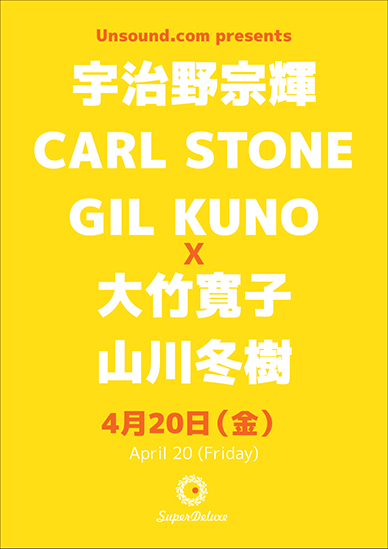
2018/04/20 金曜日金曜日
Unsound.com presents 'UJINO / Carl Stone / Gil Kuno + Hiroko Otake / Fuyuki Yamakawa'Unsound.com presents 「宇治野宗輝 / カール・ストーン / ギル久野+大竹寛子 / 山川冬樹」
Open: 19:30 | Start: 20:00 - 22:30
前売/Advance: ¥0.00 | 当日/Door: ¥3000
ドリンク別/Plus drink
- Export:
- iCal

予約する/Reserve
出演:
宇治野宗輝
カール・ストーン
ギル久野+大竹寛子
山川冬樹
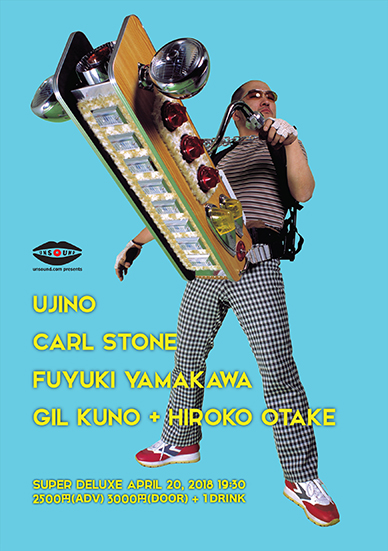
出演者詳細:
宇治野宗輝
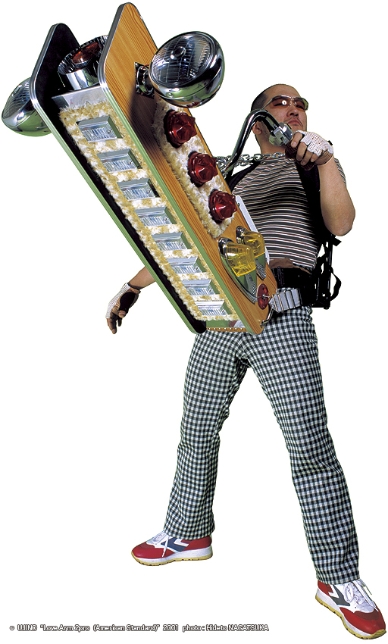
1964年東京都生まれ。90年代より「LOVE ARM(ラヴ・アーム)」シリーズをはじめとするサウンドスカルプチャーを制作、またそれらを使ったライヴパフォーマンスを行っている。2004年からは、大量消費社会が急速に拡大した20世紀以降の「物質世界のリサーチ」を基盤に、楽器、家電製品や自動車、家具、中古レコードなど、世界中どこにでもある日常的なモノと技術を再構成し、近代の文化を再定義するサウンド/スカルプチャー/パフォーマンスの複合プロジェクト「The Rotators」に取り組み、日本のみならず世界各地の展覧会に参加している。ヨコハマトリエンナーレ2017に参加。
宇治野宗輝 official site
カール・ストーン
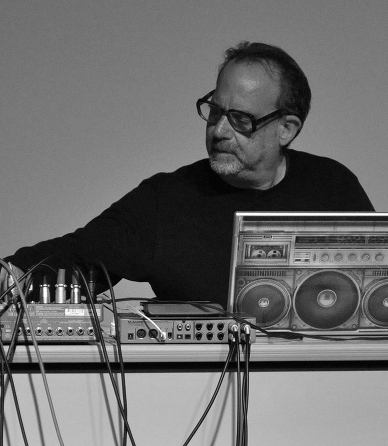
現在のコンピュータミュージックの先駆者の一人であり、ヴィレッジボイス誌は『サンプリングの王者』『現在のアメリカで最も優れた作曲家の一人』と賞賛している。彼は1986年からライブパフォーマンスでコンピューターを使用している。ストーンはロサンジェルスで生まれ、現在はロサンゼルスと日本を拠点に活躍している。カリフォルニア芸術大学で、Morton Subotnick, James Tenneyに師事し、1972年から電子アコースティック音楽の作曲を始めたが、この分野は殆ど彼の独壇場である。その作品は、アメリカ・カナダ・ヨーロッパ・アジア・オーストラリア・南米・北東アフリカなどで演奏されており、演奏活動の他に作曲やコンサートツアーも行い、日本の中京大学工学部メディア工学科の教授でもある。日本のアーティストとコラボレーションは大友良英,高橋悠治、清水靖晃、田中悠美子、渋谷慶一郎、中村としまる、ギル久野、内橋和久、桜井真紀子、恩田晃、高橋アキ、赤い日ル女、他
Carl Stone official site
ギル久野+大竹寛子
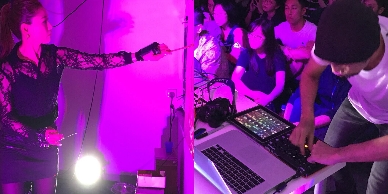
ギル久野
呼吸する腸、マスターベーションのインスタレーション、巨大なアリの巣、無音のDJイベント、1弦ギターで編成されたオーケストラなど、彼は我々の現実認識を常に打ちのめしてくれる。
unsound.com
大竹寛子
私がモチーフとして扱う蝶や花に重ねるイメージは、常に流動的な現在の瞬間です。目の前に見えている現象は脳の中で作られるイメージであり、既に目の前には無い残像であると感じています。そんな流動的な瞬間の中にこそ恒常的な精神があるのではないかという想いを作品をとおして表現しています。蝶はギリシャ語で“Psycheプシュケー”呼吸や息を意味し、転じて生きること、また心や魂を意味するようになった言葉といわれています。その言葉のもつ意味を私なりに解釈し、蝶を魂の成長の象徴として、揺らぎあるものの象徴として、またつかめそうで流動的な時間や感覚の象徴として記号化させ画面の中に登場させています。流動的で儚いものをあるがままに受け入れて、自然の中にそれを見出し、そこから精神的な成熟を試みてきたのが日本人としてのアイデンティティーでもあると感じています。日本文化を現代に生きる自分なりに解釈し表現する事で、脈々と受け継がれてきた日本の精神性(アニミズム、多神教的思考、余白の美、空気感など)を振り返り、日本画という言葉を超え一表現者として制作活動を行っていきたいと思っています。
大竹寛子 official site
山川冬樹
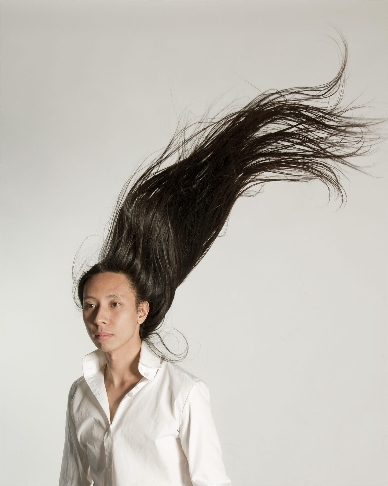
ホーメイ歌手/現代美術家。声と身体を扱った表現で、音楽、現代美術、舞台芸術の分野で活動。電子聴診器を用いて心音を増幅してみせるパフォーマンスや、 骨伝導マイクで頭蓋骨の共鳴を増幅したパフォーマンスで、ヴェネツィア・ビエンナーレ、フジロック・フェスティバル、国内外のノイズ/即興音楽シーンなど、 ジャンルを横断しながらこれまでに15カ国でパフォーマンスを行う。また一人で同時に二つの声で歌うと言われる、アジア中央部の伝統歌唱「ホーメイ」の名手として知られ、2003年ロシア連邦トゥバ共和国で開催された「ユネスコ主催第4回国際ホーメイフェスティバル」では「アヴァンギャルド賞」を受賞。現代美術の分野では、個人と社会の記憶が交差するインスタレーション「The Voice-over」(2008年/東京都現代美術館蔵)、「パ」という音節の所有権を、一人のアートコレクターに100万円で販売することで成立するパフォーマンス、『「パ」日誌メント』などを発表。2015年横浜文化賞文化・芸術奨励賞受賞。
山川冬樹 official site
Live:
UJINO
Carl Stone
Gil Kuno + Hiroko Otake
Fuyuki Yamakawa

Artist information:
UJINO

UJINO was born in 1964 in Tokyo. Since the 1990s, UJINO created a number of sound sculptures including LOVE ARM series and made live performances. In 2004 the artist initiated his best known The Rotators, a project of sound/sculpture/performance installations made of omnipresent products like electric home appliances, automobiles, furniture, old records and decorative lights combined and transformed to function like an automatic rhythm playing system. This project has lead to a number of exhibition and performance opportunities inside and outside Japan.Participated in Yokohama Triennale 2017.
UJINO official site
Carl Stone

Carl Stone is one of the pioneers of live computer music, and has been hailed by the Village Voice as “the king of sampling.” and “one of the best composers living in (the USA) today.” He has used computers in live performance since 1986. Stone was born in Los Angeles and now divides his time between Los Angeles and Japan. He studied composition at the California Institute of the Arts with Morton Subotnick and James Tenney and has composed electro-acoustic music almost exclusively since 1972. His works have been performed in the U.S., Canada, Europe, Asia, Australia, South America and the Near East. In addition to his schedule of performance, composition and touring, he is on the faculty of the Department of Media Engineering at Chukyo University in Japan. A winner of numerous awards for his compositions, including the Freeman Award for the work Hop Ken, Carl Stone is also the recipient of grants from the National Endowment for the Arts, the Rockefeller Foundation and the Foundation for Performance Arts. In 1984 he was commissioned to compose a new work premiered as part of the Olympic Arts Festival in Los Angeles. His music was selected by the dancer/choreographer Bill T. Jones for the production 1-2-3. in that same year. In 1989 he resided for 6 months in Japan under a grant from the Asian Cultural Council and in that same year, The Museum of Contemporary Art, Los Angeles commissioned a new work, Thonburi as part of the radio series “Territory of Art”. In 1990 he was commissioned to create music for a 60-minute program for ZDF Television in West Germany entitled Made in Hollywood. In 1991 he received separate commissions from Michiko Akao (She Gol Jib, for traditional Japanese flute and electronics), Sumire Yoshihara (for percussionist and electronics) and Sony PCL (Recurring Cosmos, for High Definition video and electronics), which was awarded special honors at the International Electric Cinema Festival in Switzerland in 1991. In 1993, he was commissioned by the Paul Dresher Ensemble to create a new work, Ruen Pair, with funds from the Meet the Composer/Reader’s Digest Commissioning Program. In 1994 he was commissioned by the Strings Plus Festival, Kobe to create Mae Ploy, for string quartet and electronics. In that same year he also created Banh Mi So, for ondes martenot and piano, at the request of Takashi Harada and Aki Takahashi. In 1995, he was commissioned by NTT/Japan to create a new work for the internet , Yam Vun Sen, as part of IC95. In 1996, with support from the Rockefeller Foundation, he created music for The Noh Project, a collaboration with choreographer June Watanabe and Noh master Anshin Uchida. In 1997 he was commissioned by Bay Area Pianists and Cal Performances to create a new work, Sa Rit Gol, for disklavier and pianist, as part of the Henry Cowell Centennial Celebration at UC Berkeley. Other festival performances in 1997 included Other Minds (San Francisco) and TonArt (Bern). In 1999 he was invited as Scholar-in-Residence at the Rockefeller Foundation Bellagio Study and Conference Center. In 2001 he served as Artist-in-Residence at the International Academy of Media Arts and Sciences (IAMAS) in Japan, and in that same year he joined the faculty of Chukyo University’s School of Cognitive and Computer Sciences.In 20011 he was named an Artist Fellow by the Civitella Ranieri Foundation in Italy. Recordings of Carl Stone’s music has been released on New Albion, CBS Sony, Toshiba-EMI, EAM Discs, Wizard Records, Trigram, t:me recordings, New Tone/Robi Droli, Unseen World and various other labels. Carl Stone’s music has been used by numerous theater directors and choreographers including Hiroshi Koike, Akira Kasai, Bill T. Jones, Setsuko Yamada, Ping Chong, June Watanabe, Kuniko Kisanuki, Rudy Perez, Hae Kyung Lee, and Blondell Cummings. Musical collaborations include those with Akaihirume, Michiko Akao, Pearl Alexander, Samm Bennett, Sarah Cahill, Gianni Gebbia, Mineko Grimmer, Haco, Alfred Harth, Madoka Kono, Gil Kuno, Min Xiao-Fen, Otomo Yoshihide, Kazue Sawai, Elliot Sharp, Yasuaki Shimizu, Stelarc, Aki Takahashi, Yuji Takahashi, Tosha Meisho, Kazuhisa Uchihashi, Wu Na, Wu Wei, Michiyo Yagi, Miki Yui and z’ev. Carl Stone served as President of the American Music Center from 1992-95. He was the Director of Meet the Composer/California from 1981-1997, and Music Director of KPFK-fm in Los Angeles from 1978-1981. He often hosts a weekly program on KPFA-fm in the Bay Area USA. Other activities have included serving as a regular columnist for Sound & Recording Magazine in Japan, serving as web editor for Other Minds, a world wide web site devoted to New Music, and for the official web site of the John Cage Trust.
Carl Stone official site
Gil Kuno + Hiroko Otake

Gil Kuno
Through careful social conditioning, the mind is guided to think within certain patterns. Gil tries to redirect the flow of the mind outside of the set patterns we are taught by society to construct. In his work, he attempts to displace natural activity from its context, revealing an otherwise hidden level of metaphorical absurdity within the ordinary patterns present before our eyes. The goal of sublimating everyday perception underlies many of the projects he has exhibited or performed. He aims to push people away from paradigmatic thinking through various themes and methodologies – aleatoric systems (chance operations,) exaggerated perception, derailed reality and re-envisioning experiences common within everyday life. He has collaborated with artists such as Eye Yamantaka (Boredoms,) Yoshimi (Boredoms, OOIOO,) Battles, Vincent Gallo, Ken Ishii, Tatsuya Yoshida (Ruins,) Carl Stone, Alec Empire (Atari Teenage Riot,) Steve Albini (Big Black, Shellac,) Cristian Vogel, Zbigniew Karkowski, Merzbow, GX Jupitter Larsen (The Haters,) Nissennenmondai, Christian Galarreta, Joseph Hammer, Patric Catani (EC8TOR). Gil received his MFA at UCLA. He has achieved recognition from Ars Electronica, Japan Media Arts Festival, Canon Digital Creators Contest, Timothy Leary (Leary.com), among others.
unsound.com
Hiroko Otake
The main themes of my paintings are butterflies and flowers. They are coupled together into never ending instants, veiled in uncertainty, where every minute of existence is constantly renewed. I can feel sincerity and candor while observing the nature and the butterflies. Butterfly here means “Psyche” (from the Greek “ψυχή “ (psūkē) was “life” in the sense of “breath”, “spirit”, “soul”. And ultimately “ego” in the sense of “conscious personality”) I thus paint butterflies in my works representing these symbols: soul, mind, “Numen”(the power of God) , but also beauty, shimmer, and spiritual renaissance. I started painting butterflies as I felt that similar to them I was able to modify and renew shape, with the unrestricted chances deriving from the ephemeral and transient nature of the change. While painting butterflies and focusing my mind on the literature concerning such theme I have discovered their many symbolic meanings. Through my work I want to express my impressions and feelings combined with the symbolism of butterflies.
Hiroko Otake official site
Fuyuki Yamakawa

Born in London UK on 1973. Based in Tokyo Japan. Fuyuki Yamakawa -creator of sound/visual installations and improvised musical happenings – picks up and amplifies the sound of his heartbeat with an electronic stethoscope. At the same time this triggers the lighting of a series of light bulbs that oscillate simultaneously with the heartbeats, themselves cadenced to the rhythm of his ‘Khoomei’, a form of popular Tuvan (central asian) overtone singing in which Yamakawa excels, characterised by diplophonia, which is the contemporary emission of two sounds requiring total control of one’s breathing. Through his vocalisation, he controls his heartbeat’s speed and velocity. ” My physical body`s phenomena is outputted as sound and light and it gives perceptional stimulations to eyes, ears, and skins of audiences. Eventually the venue transforms into extended part of my body,” he says. ” Sometimes it stops my heart for seconds. I use electric guitar but I never touch the strings. I shake and rub the body of guitar to make drones. These actions work like ‘sports’, which influence heart beat.” With a background in video art and graphic design, in 2001 he won the Grand Prix and Audience Award at the 1st Khoomei Festival in Japan (September) and started his professional career as a voice performer. In 2003, he was invited to the 4th International Khoomei Festival, which was held in the Republic of Tuva. He won the Avant-garde Award in the contest and became known as an Avant-garde Khoomei singer. In the same year, he participated in the 2nd Khoomei festival in Japan and succeeded in defending his championship title.
Fuyuki Yamakawa official site
More great eventsこちらもどうですか
このカテゴリーにはまだないみたい / No events in this category
Via hashtagハッシュタグから
まだありません/No Tweets Found